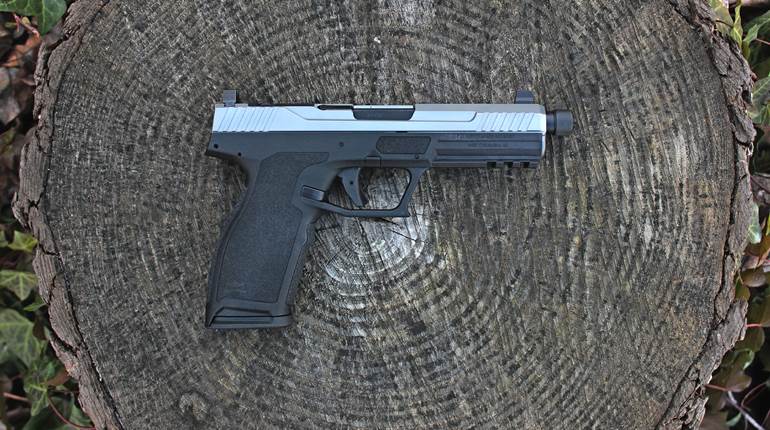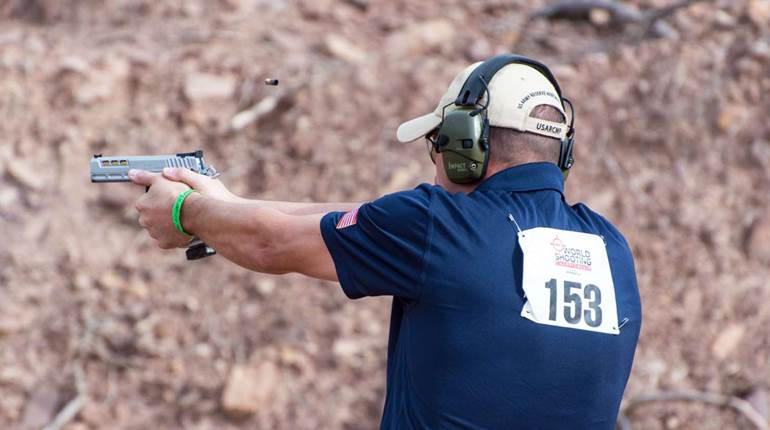Several years ago, the research and development team at Sturm, Ruger & Co. set out to produce the company’s next generation of striker-fired polymer-frame pistols. Recognizing that the new platform would be launched into a market replete with semi-automatics competing in the same size and caliber categories, it carefully considered how to meet the needs of its customers while standing out from the crowd. It was important to find that often-elusive, just-right balance of features, function and price because this handgun was destined to be the first pistol in the Ruger American line. It was decided that the new semi-automatic would not be based on the successful SR series. Ruger wouldn’t settle for giving the SR a few cosmetic tweaks and calling it a new model. Rather, the development team initially dug into the U.S. Military’s Joint Combat Pistol Specification, and then the subsequent Modular Handgun System (MHS) program, with the goal of producing a pistol that would meet or exceed the military’s requirements. At the same time, it consulted with law enforcement trainers around the country to find out what they were looking for in a duty sidearm. The result of all this work is the new line of Ruger American Pistols chambered in 9 mm Luger and .45 ACP. This review takes a closer look at the 9 mm version. 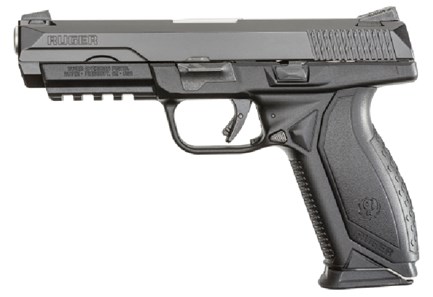
The Ruger American Pistol is a full-size semi-automatic that utilizes a Browning-type locked-breech action. A unique modification to the action is a patent-pending barrel cam scientifically designed to reduce felt recoil by controlling rearward movement of the slide as a cartridge is fired. Spreading the recoil impulse out over time causes the gun not to be driven into the shooting hand all at once, reducing the sense of a sharp or unpleasant kick. It also provides for reliable function with a lighter slide. The barrel cam and light-weight slide combine with a low bore axis to reduce muzzle flip for quick follow-up shots.
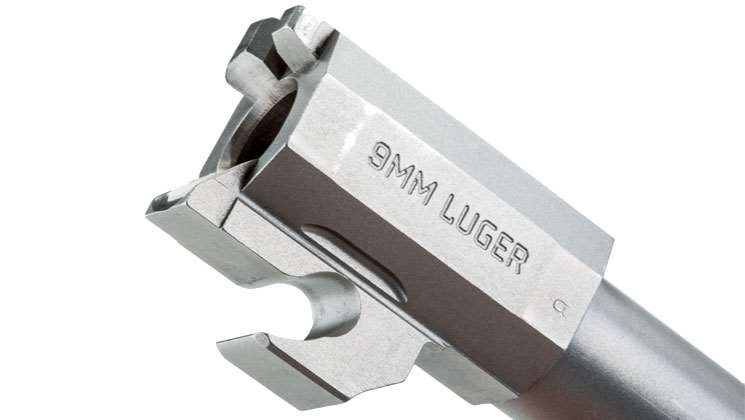
The slide is topped with an authentic, metallic, Novak LoMount three-dot sight system. The front sight blade is dovetailed into the slide just like the windage-adjustable rear sight. Ruger plans to offer several other sight options for the American Pistol, including night sights, through their online store (shopruger.com) for those customers who want them.
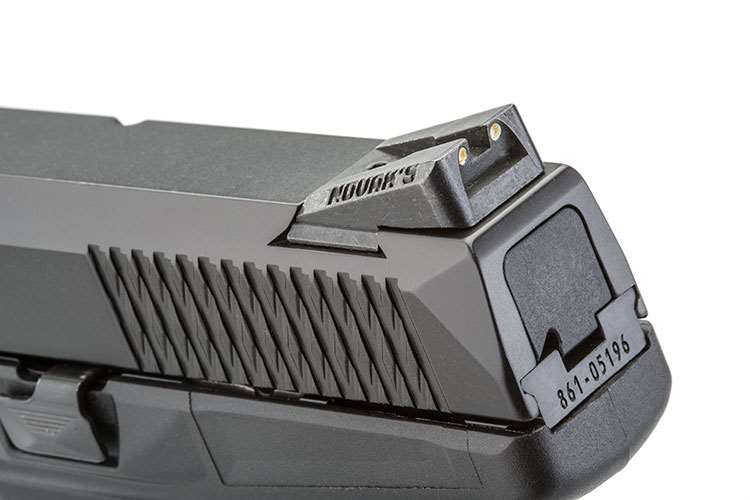
The stainless steel barrel contains traditional six-land-and-groove rifling, which allows the use of lead and jacketed bullets. The top of the barrel’s chamber is notched with a small witness hole that serves as a loaded chamber indicator. The recoil assembly consists of a single, flat wire spring captured on a straight guide rod, much like a Gen3 Glock. But unlike the Austrian pistols, the guide rod’s components are all steel rather than polymer.
The new pistols employ what Ruger is calling a pretensioned striker-ignition system. Some striker designs use the cycling of the slide to partially cock the striker, which is then fully cocked by depressing the trigger. When the slide of the American Pistol is cycled, the striker is set into a fully cocked position. This means the trigger only has to release the sear, resulting in a shorter, crisper trigger pull.
It’s not uncommon for modern polymer-framed pistols to use molded-in sheet metal or MIM armatures to support the slide assembly as it cycles. Ruger opted to take a page from the SIG Sauer playbook and do away with multi-piece supports in favor of a single-piece chassis. CNC machined from stainless steel and then nitride treated, the ridged chassis features 1.5” integral front and rear slide rails while providing total support for the firing mechanism. This means all of the major moving components of the pistol are sliding against steel support surfaces, not the polymer of the frame. The chassis is the serial numbered component of the gun with the number visible just under the back end of the slide.
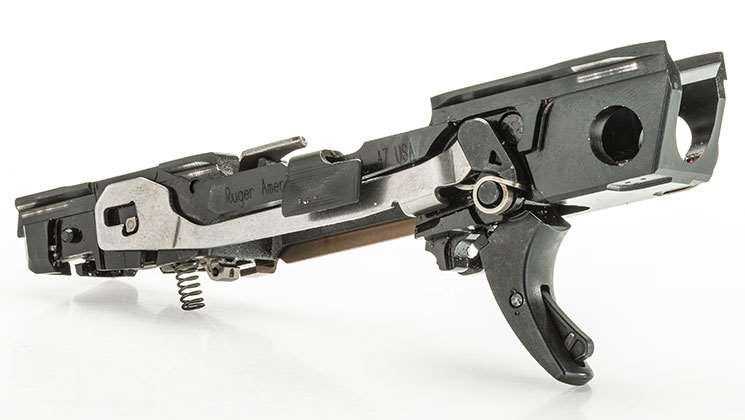
The curved steel trigger features a smooth face and a central trigger safety lever to keep the pistol from firing unless the trigger is fully depressed. The “Pro” Model of the Ruger American Pistol does not have any other external safeties, although it does have an internal, automatic sear-block system that prohibits striker movement until the trigger is completely pressed to the rear. The “Standard” model of the American Pistol is expected to be configured with an external thumb safety and magazine disconnect in addition to the safeties found on the Pro Model.
External controls consist of a left-side take-down lever, a bilateral slide lock and a wedge-shaped bilateral steel magazine release. The trigger is best described as two-stage with a light take-up through about two-thirds of its travel. Once it meets the resistance of the sear, which is retains the pretensioned striker, Ruger says users will need to exert about 6 lbs. of trigger pressure for a clean, crisp break. The trigger completes its reward journey by coming to rest against a small over-travel stop molded into the trigger guard. The pistol evaluated for this review exhibited a 5-lb., 14-oz. trigger pull which was in line with its specifications.
The polymer frame and wrap-around grip modules are formed from black glass-filled nylon. This material is stronger and more ridged than other nylons which, in turn, allows the frame to be thinner and lighter. A 2” long accessory rail, designed to accommodate laser and light modules, is molded into the frame in front of the generous, squared-off trigger guard.
The grip frame is ergonomically shaped to fit a variety of hand sizes. The trigger guard is undercut above the front strap and recesses for the trigger finger and thumb are found just behind the trigger guard to make it easier to form a comfortable grip. The front strap has straight profile (no finger grooves) with a dense diamond-pattern texturing Ruger has dubbed Purpose Oriented Texture. The sides of the grip are nearly smooth with widely spaced diamonds along the curved backstrap.
The Ruger American Pistol in 9 mm Luger arrives with three interchangeable wrap-around grip modules that provide for varying hand size and trigger reach. They are held in place by a locking cam which is accessed through a port in the center of the module using a provided wrench. A one-quarter turn to the left releases the cam. The temptation when removing a grip module is to squeeze it tightly and pull hard, which makes removal difficult. It only takes a little pressure in the right directions to make the exchange, so owners are advised to take a minute to look at the manual and follow the instructions to ensure the grip change goes smoothly.
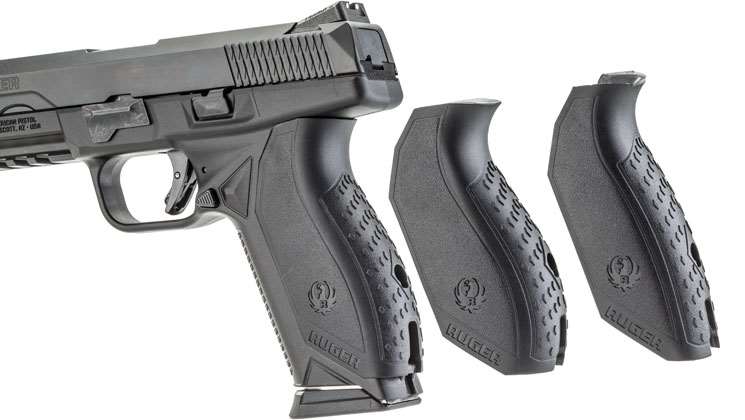
A good deal of thought went into the size and shape of the grip modules to ensure a good fit for as many operators as possible. The largest module has a distinctive, hand-filling palm swell with a trigger reach of 2.85” (measured from the center of the trigger face to the top curve of the back strap). The Medium module has a moderate swell with a trigger distance of 2.75”, with the smallest module providing a nearly straight profile and a trigger distance of 2.55”. While 0.30” may not seem like much, it can make a tangible difference when placing the pad of the trigger finger properly.
The smallest module is a smart addition to the accessory set because it makes the platform much more accessible to small-handed shooters. Not only is the trigger easier to reach for shorter fingers, the slide lock and magazine release are more accessible as well. Just below the backstrap is a lanyard attachment loop, a feature that meets certain military requirements but seldom used by civilians or law enforcement. That said, the loop is unobtrusive.
This pistol arrives with two, 17-round, nickel-Teflon-plated, steel double-stack magazines with black polymer followers and modified baseplates. The baseplate has an angled cut along the back edge that aligns with a 0.30” lip extending below the magazine well. The lip does provide a little added guidance when performing a quick reload, but its primary purpose is to protect the shooting hand from being pinched between the grip and baseplate when a magazine is slammed home.
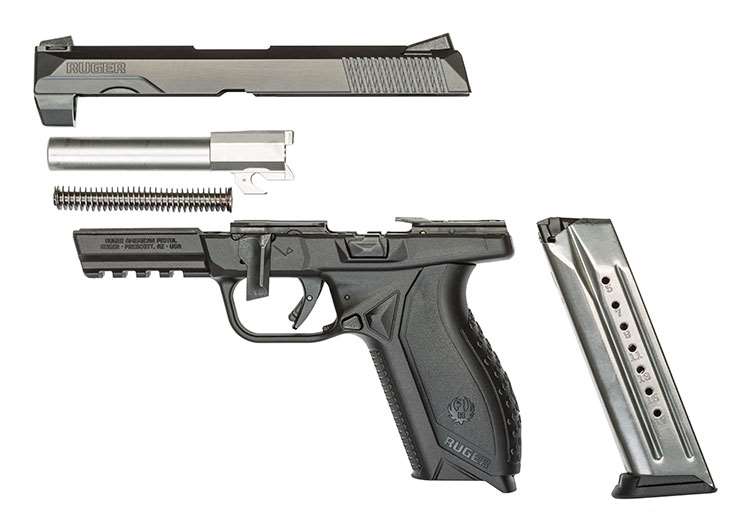
Field stripping the Ruger American Pistol for cleaning and maintenance is simple, fast and safe. It’s not necessary to depress the trigger when taking the pistol apart. Instead, start by locking the slide into the open position and removing the magazine. Inspect the chamber to verify that there is no ammunition inside the gun. With the slide in the open position, rotate the takedown lever from the 3 o’clock to the 6 o’clock position (the takedown lever will not rotate fully into place unless the magazine is removed). The takedown lever then remains fixed in the frame. While holding the slide, release the slide stop and then ease the slide assembly forward and off of the frame. Remove the guide rod and barrel from the slide, and the pistol is ready to clean. Reversing these steps to reassemble the pistol is just as easy.
The pistol passed all of its bench checks with flying colors. Only minimal lubrication was needed (lubrication points are detailed in the instruction manual) to prepare the American Pistol for live fire testing. The pistol reviewed here was a production model with the same accessory set Ruger customers will receive. The overall fit and finish was excellent. The slide cycled smoothly right out of the box, as did the trigger. All of the controls worked properly. Magazines locked neatly into place and dropped free of the grip when the release was depressed from either side of the frame. The polymer-to-metal fitting was tight, and the pistol arrived free of dings and scratches. 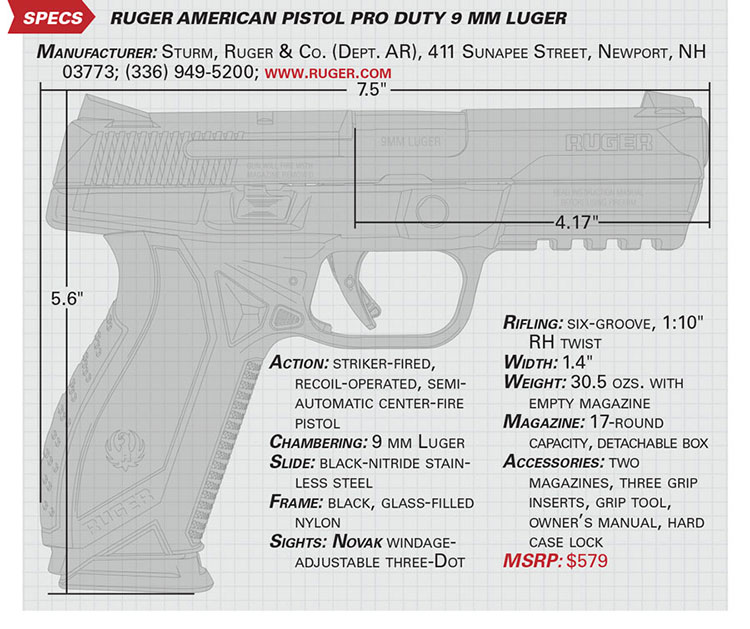
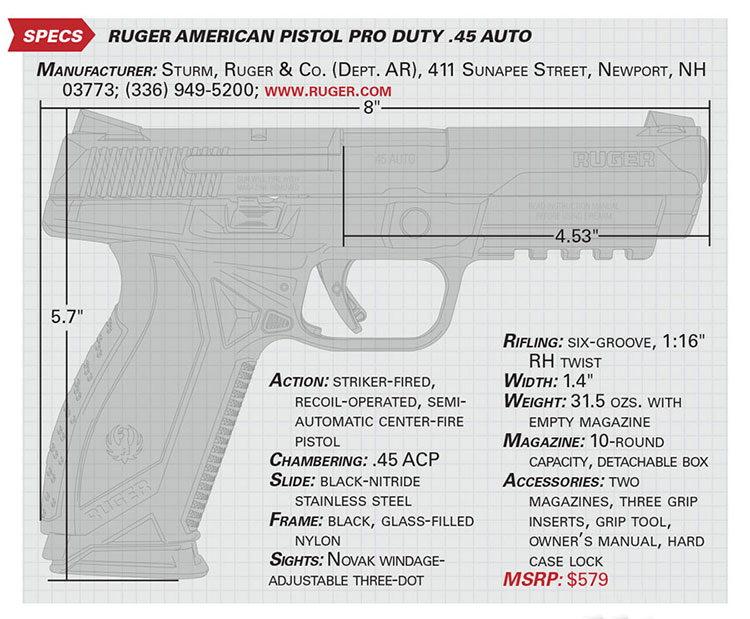
At the shooting range, the Ruger American Pistol kept its promise of providing a comfortable, manageable level of felt recoil. Although +P rounds exhibited a more snappy comeback than their standard-velocity counterparts, the recoil ranged from modest to moderate levels. This easy-going attitude, combined with the pistol’s good balance, useful sights and carefully crafted grip frame makes it a solid choice for first-time shooters and seasoned professionals alike. Thanks to the light take-up and clean break, the trigger was smooth and comfortable to work. The click of the short trigger reset was certainly present but not quite as distinctive as with some other designs. This subtlety of the trigger reset was not a deal breaker, even though
it took a while to get a feel for it. 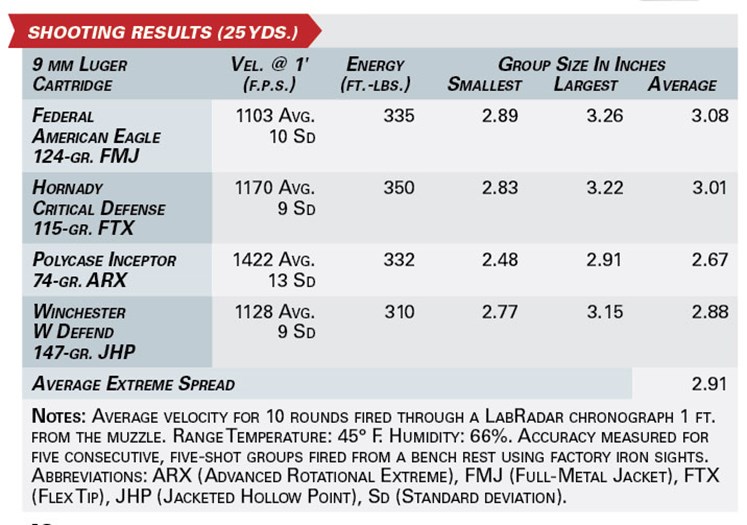
After evaluating the features of a striker-fired 9 mm Luger, the next question gun buyers ask is almost always related to the pistol’s durability—can it safely handle +P loads? If so, how often can high pressure ammunition be fired before causing significant levels of wear and tear? While evaluating this gun I had the opportunity to meet with Brandon Trevino, Ruger’s product manager in the Prescott, Ariz., factory where the Ruger American Pistol is built. He explained that one of the company’s primary goals in adhering to military standards while developing the American Pistol was to ensure that every component would successfully survive 20,000 rounds of firing without the need for replacement or repair. Not only did the Ruger American Pistol meet this standard it flew right past it with over 25,000-rounds of 9x19 mm NATO ammunition fired (the military round operates at near +P pressure levels).
As for the pistol I worked with, it operated flawlessly with no malfunctions throughout the entire testing process using 9 mm Luger ammunition ranging from bulk practice loads to premium defensive hollow points. Bench rested five-shot groups demonstrated solid defensive accuracy with group sizes averaging right around 3” at 25 yds.
It’s understandable that some folks will roll their eyes at the arrival of another polymer-frame, striker-fired pistol in a seemingly saturated market. Nevertheless, the new Ruger American Pistols offer a long list of useful and unique features at a relatively tame suggested retail price of $579 (actual price at the counter may be lower). It’s also good to know that all of the components and labor that go into constructing these guns are 100-percent American. To learn more, visit ruger.com.
